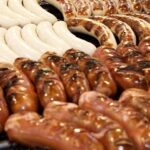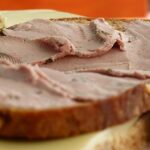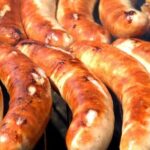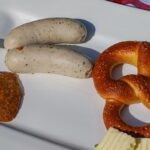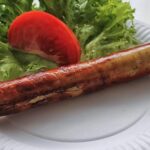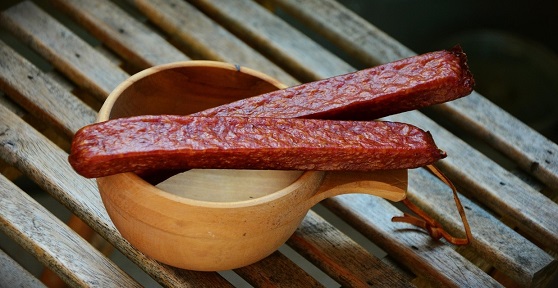
If you’ve ever hiked the Alps, explored the German countryside, or stopped at a roadside kiosk in Bavaria or Switzerland, you’ve probably encountered Landjäger – the rectangular, reddish-brown sausage that fits perfectly in your hand (and backpack).
Unlike most fresh sausages, Landjäger is firm, dried, shelf-stable, and ready to eat without refrigeration. Mildly spiced and often sold in pairs, it’s a favorite among hikers, campers, hunters, and schoolchildren alike. Whether eaten on the trail or with a cold beer at a snack stand, Landjäger is Germany’s most practical sausage.
This article covers what Landjäger is, how it’s made, what makes it unique, and how to enjoy it at its best.
What Is Landjäger?
Landjäger is a semi-dry, cured, smoked sausage made from beef and pork, known for its rectangular shape, firm texture, and long shelf life. It’s ready to eat without cooking and doesn’t require refrigeration – ideal for outdoor adventures.
The name “Landjäger” loosely translates to “country hunter,” referring either to its rural origins or its popularity among hunters and foresters.
Key Features:
- Made from beef, pork, lard, and spices
- Stuffed into a rectangular mold or pressed casing
- Smoked and air-dried
- Sold in pairs, linked together
- Shelf-stable for weeks
Ingredients and Flavor Profile
Landjäger’s seasoning is subtle but satisfying – slightly smoky, mildly salty, and lightly spiced. Its chew is firm, with a flavor closer to salami than bratwurst.
Typical Ingredients:
- Beef and pork (roughly 1:1 ratio)
- Pork fat (lard)
- Salt and curing salt
- Sugar or dextrose
- Garlic, pepper, coriander, and caraway
- Optional: red wine, paprika, or chili for regional versions
Texture and Appearance
- Texture: Firm, dry, and chewy (not spreadable)
- Color: Deep reddish-brown exterior, with a darker red interior
- Size: Usually 12-15 cm long, about 2.5 cm wide
- Shape: Flat and rectangular – pressed during drying
Its dense consistency makes it satisfying to eat in small portions and ideal for on-the-go snacking.
How Landjäger Is Made
Landjäger is a semi-dried, cured, and smoked sausage that relies on time-honored preservation techniques: salting, curing, smoking, and drying. Its distinctive firm texture and rectangular shape result from careful processing and pressing during fermentation and aging.
The production process varies slightly between regions, but the following method reflects traditional preparation as used by butchers in southern Germany and Switzerland.
Step-by-Step Production: Traditional Landjäger Method
1. Select Quality Meats
- Combine lean beef and pork shoulder in a 1:1 ratio for a balanced texture and flavor.
- Add pork back fat to ensure the sausage doesn’t dry out during curing.
- Meat and fat must be very fresh, and kept cold (just above freezing) to prevent bacterial growth.
2. Grind the Meat and Fat
- Use a medium-coarse grind (4-5 mm plate) to preserve some texture.
- The mixture should feel slightly sticky and moist, not too dry or oily.
3. Add Cure and Seasonings
Mix the meat with:
- Curing salt (typically 2.5% of meat weight) for preservation and color
- Sea salt, sugar or dextrose (aids fermentation)
- Spices like black pepper, caraway, coriander, garlic powder, and sometimes red wine for aroma and acidity
Some recipes also include a starter culture to help ferment the sausage safely by lowering the pH during the early stages of drying.
4. Mix and Bind Thoroughly
- Mix the seasoned meat until the proteins begin to bind, forming a cohesive, sticky mass.
- This step is critical to ensure proper structure and flavor development during curing.
5. Stuff into Casings and Shape
- Stuff the meat mixture into natural pork or collagen casings, typically 28-32 mm in diameter.
- Once filled, sausages are pressed into flat, rectangular molds or gently compressed by hand and tied into their traditional shape.
- Each link is usually 12-15 cm long, paired in twos and twisted at the center.
6. Cold Smoke
- Landjäger is cold-smoked at 15-25°C (59-77°F) for 6 to 12 hours, often over beechwood, oak, or alder smoke.
- This imparts a delicate smokiness and helps with surface drying.
7. Fermentation and Drying (Ripening)
- After smoking, sausages are hung in a curing chamber or drying room with:
- Temperature: 12-16°C (54-61°F)
- Humidity: 75-85%, slowly decreasing
- They ferment and dry for 5-14 days, depending on the climate, recipe, and desired firmness.
- During this stage:
- Moisture is reduced
- pH drops slightly due to mild fermentation
- Flavor deepens and the sausage firms up to its iconic chewy texture
The end result is a shelf-stable, dry-cured sausage with a firm bite, light tang, and subtle smoky aroma – all achieved without cooking.
Thanks to curing and drying, Landjäger can last weeks without refrigeration, making it an old-school form of meat preservation.
How to Eat Landjäger
No Cooking Needed:
Landjäger is ready to eat straight from the package – no heating, boiling, or slicing required. It’s often:
- Bitten into like a beef stick or jerky
- Eaten whole as a snack
- Sliced into cheese boards, cold platters, or trail mixes
Serving Ideas:
- On a Brotzeit platter with cheese, pickles, and rye bread
- With crackers and apples for a hiking snack
- As a protein-rich lunchbox item
- Paired with beer, cider, or apple juice
It’s especially common at:
- Oktoberfest-style festivals
- Train station kiosks
- Hiking shelters in Alpine regions
Regional Variations
Though most Landjäger recipes are similar, you’ll find regional nuances across:
- Germany (especially Bavaria and Baden-Württemberg) – is often slightly firmer and mildly smoked.
- Switzerland – A national favorite, widely known as the ultimate hiking sausage, often enjoyed during Alpine excursions and available in nearly every supermarket or mountain hut.
- Austria – sometimes spicier or made with wine
- Alsace (France) – with stronger garlic notes and red wine
Some butchers even produce chili-spiked or cheese-filled versions.
Storage and Shelf Life
Unopened:
- Shelf-stable at room temperature for 2-4 weeks
- Best stored in a cool, dry place
Opened:
- Once opened, keep refrigerated and consume within 5-7 days
- Wrap in parchment or store in a breathable container to maintain dryness
Freezing:
- Freezing is possible but may affect texture slightly
Landjäger gets firmer and more intense in flavor the longer it dries.
Nutritional Notes
- High in protein, moderate in fat
- Low in moisture, so calorie-dense
- No artificial preservatives if made traditionally
- Ideal for high-energy outdoor activity (hiking, biking, skiing)
Landjäger Fun Facts
- Landjäger is so portable that German soldiers carried it in field rations during both world wars.
- The rectangular shape helps prevent rolling and fits easily into jacket pockets.
- In Switzerland, it’s called “the hiker’s energy bar”.
- Popular among hunters, scouts, cyclists, and even commuters as a no-mess snack.
Compact, durable, and deeply satisfying, Landjäger is Germany’s answer to portable protein. Its smoky flavor, chewy bite, and legendary shelf life make it perfect for travel, trail, or a rustic Brotzeit platter at home.
Whether you take it on a mountain hike or slice it for a snack board, Landjäger proves that sometimes the best sausages don’t need a pan, pot, or plate – just appetite and adventure.
Want more dried meat traditions? Compare it with Mettwurst or explore German Brotzeit Boards for more regional ideas.
Related Articles:
12 Types of German Wurst You Should Know
From Bratwurst to Blutwurst, this guide introduces 12 of Germany’s most iconic sausages. Learn what makes each one unique – and how to cook or serve them.
What Is Mettwurst? Raw-Cured German Sausage Guide
Dive into the world of Mettwurst – a cured, often smoked raw sausage. Discover its regional styles, how to enjoy it safely, and what makes it different from Mett.
What Is Knackwurst? Germany’s Snappy Sausage Explained
Learn all about Knackwurst – the garlicky, juicy sausage that snaps when you bite. See how it’s made and served across Germany.
What Is Bockwurst? Mild German Sausage Explained
Bockwurst is Germany’s mild, family-friendly sausage. Find out why it’s beloved by all ages and how to poach and serve it the right way.
What Is Blutwurst? Traditional German Blood Sausage
Blutwurst is Germany’s traditional blood sausage – rich, hearty, and historic. Learn how it’s made, regional styles, and how to cook or enjoy it cold.
Nürnberger Rostbratwurst – Recipe and History
Explore the legacy of Nürnberger Rostbratwurst – the small sausage with big flavor. Includes authentic preparation methods and cultural background.
The Best Homemade Currywurst Recipe
Make authentic Berlin-style Currywurst at home with this easy recipe. Includes sausage prep, homemade curry ketchup, and street food-style serving tips.
Frankfurter Würstchen – The Original German Hot Dog
Discover the authentic Frankfurter Würstchen – Germany’s original hot dog. Learn its history, protected status, and how to heat and serve it the traditional way.
Teewurst – Soft German Sausage for Spreading
Explore Teewurst, the smoky, spreadable sausage originally served at tea time. Find out how it’s made, stored, and delicious ways to enjoy it at home.
How to Make Traditional German Bratwurst at Home
This detailed recipe guide walks you through making real German Bratwurst from scratch – with tips on ingredients, grinding, stuffing, and grilling.
